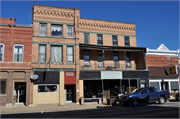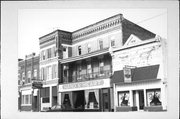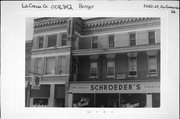Property Record
1520-1522 COMMERCIAL ST
Architecture and History Inventory
| Historic Name: | Elsen House Hotel |
|---|---|
| Other Name: | |
| Contributing: | Yes |
| Reference Number: | 16892 |
| Location (Address): | 1520-1522 COMMERCIAL ST |
|---|---|
| County: | La Crosse |
| City: | Bangor |
| Township/Village: | |
| Unincorporated Community: | |
| Town: | |
| Range: | |
| Direction: | |
| Section: | |
| Quarter Section: | |
| Quarter/Quarter Section: |
| Year Built: | 1900 |
|---|---|
| Additions: | |
| Survey Date: | 19922020 |
| Historic Use: | lodging-hotel |
| Architectural Style: | Italianate |
| Structural System: | |
| Wall Material: | Brick |
| Architect: | |
| Other Buildings On Site: | |
| Demolished?: | No |
| Demolished Date: |
| National/State Register Listing Name: | Bangor Commercial Historic District |
|---|---|
| National Register Listing Date: | 10/11/2022 |
| State Register Listing Date: | 2/18/2022 |
| National Register Multiple Property Name: |
| Additional Information: | This three-story Italianate building was constructed in 1900. It is rectangular in plan with buff-colored brick walls and a flat roof. The building shares party walls on both sides. The front elevation faces south and is asymmetrical in plan with a full-height projecting bay at the western end of the façade. Within this bay is a recessed entrance adjacent to a shopfront that has been infilled with brick and vertical board with a downsized single-pane window. An iron lintel with regularly spaced rosettes spans the wall above the storefront and recessed entry. Above this, at the second story of the projecting bay, is a single-pane window with 1-over-1 windows on each side. This arrangement is mirrored in the windows at the third story with slightly shorter single-pane and 1-over-1 windows. Painted stone drip courses span the projecting bay below the second and third stories, acting as sills for the windows. Flush bands of painted trim span the wall above the second and third story windows. Wide bands of decorative brickwork cap the projecting bay. A corner pilaster spans the full height at the eastern corner of the project bay; this is capped by a stylized column with a corbelled base; a terra cotta panel containing the building’s year of construction (1900) is installed on the face of the corner pilaster at the first story. The remainder of the south (front) façade consists of a first story storefront, four singly-placed 1-over-1 windows at the second story, and four singly-placed 1-over- windows at the third story. All 1-over-1 windows have stone sills; the second-story windows also feature stone lintels. The storefront consists of a recessed entrance with large, single-pane shop windows on each side. The bulkhead walls below the shop windows is clad in metal panels. A wood door with a single-pane window in its upper half and a single-pane transom is located at the eastern end of the storefront and provides access to the residential spaces at the second and third stories. The wall above the storefront is clad in opaque paneling. Above this, a shed roofed porch with decorative metal supports and railings shelters the second story windows. A flush band of painted trim spans the wall above the third story windows. Above this, wide bands of decorative brickwork span the façade. The first Elsen House hotel was constructed for John Elsen in 1894 on the site of the Bangor House, one of the village’s earliest hotels; the first Elsen House hotel was destroyed by a fire in October of 1899 that started in the basement of the building and quickly spread. The existing building was constructed in 1900 and occupied the same footprint as the preceding building, but eliminated a bank of round-arched tripart windows and a small pyramidal corner pinnacle from the third story of the projecting bay and added a third story to the main building mass. Located only a short walk from the train station, the Elsen House served a variety of travelers and was long regarded as a focal point of Bangor’s downtown. The Elsen family continued to operate the hotel until 1914. In 1915, the building was purchased by Peter Burbach who had previously served as the hotel’s bartender. Following Burbach’s death in 1920, the building continued to serve as a hotel under a series of owners and was converted to a boarding house in 1940. In 1948, Wilfred Stratman established Stratman’s Bar in the former Elsen House saloon (located at the western end of the first floor); this bar operated as such until 1986. In 1950, the Elsen House was purchased by Frederick “Fritz” Schroeder who had previously maintained a livery stable in back of the building (not extant). Fritz and Marie Schroeder rehabilitated the building to serve as an apartment building with the Schroeder Appliance and Furniture Store occupying the first floor; as part of this effort, rooms on the second floor of the building were converted to serve as three apartments (with a few single rooms remaining), a staircase was removed from the hotel lobby, and the existing shop windows were installed in the space that had previously served as a porch sheltered by the balcony above. Following the closure of Stratman’s Bar in 1986, this space served as a variety of taverns and restaurants under various owners. When the Schroeder Appliance and Furniture Store closed in the early 1980s, this space hosted a series of gift shops, the last of which (known as House Warmings) remains in business today. |
|---|---|
| Bibliographic References: |
| Wisconsin Architecture and History Inventory, State Historic Preservation Office, Wisconsin Historical Society, Madison, Wisconsin |



